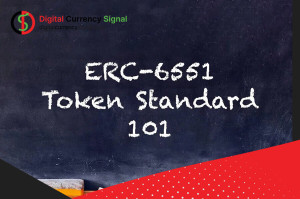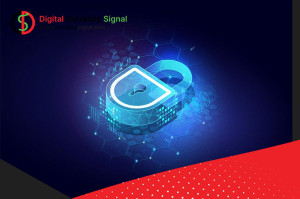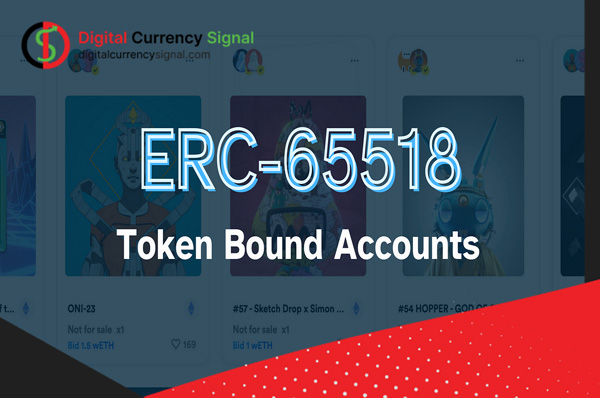The ERC-6551 standard is an unchanging token (NFT) standard that has a strong influence on this market and the NFT world today. It can be said that this standard is the latest development in the changing world of irreplaceable symbols. Thanks to these concepts, artists, game designers and content creators can now create and sell unique and unique assets on the blockchain, opening up a whole new world of possibilities.
Are you of ERC-6551 standard?
The ERC-6551 standard defines a system that allows all ERC-721 tokens to be smart contract accounts. These bond token accounts allow ERC-721 tokens to hold goods and interact with applications; No need to modify smart contracts or ERC-721 infrastructure. The ERC-6551 standard works by deploying unique, dedicated contract accounts for each ERC-721 token through a permissionless registry. This gives all ERC-721 tokens, including existing ERC-721 contracts, full Ethereum account capability. All Bond token accounts are managed by ERC-721, which allows the token to connect to the blockchain, record transaction history, and store the chain’s assets. Each token’s bond account is controlled by the ERC-721 token holder, which allows the holder to initiate chain operations on behalf of their token.
The ERC-6551 standard is a new token standard that aims to power the world of immutable tokens. This standard is similar to upgrading NFTs and turning them into smart contract wallets. In fact, NFTs can now store tokens and additional NFTs just like a standard smart contract wallet. Furthermore, it has the potential to interact with other smart contracts, opening up various possibilities. This new standard is expected to change the way we look at NFTs by enabling powerful new features for blockchain-based digital assets.
The main purpose of ERC-6551 is “permission-linked accounts”. This standard provides a better user experience for both collectors and creators of passive tokens. ERC-6551 can be said to be the newest standard added to the Ethereum ecosystem, with the first main website opening on May 7, 2023. This new standard token expands the power of ERC- 721 NFTs, allowing them to hold assets and interact with 3 Web applications.
What is a Token Bound account?
A Bond Token account is basically an NFT wallet. Using the ERC-6551 standard, a new or existing NFT can have a smart contract account associated with it. This account can hold various digital assets such as Cryptocurrencies and Proof of Attestation Protocol (POAP). Cryptocurrency bond account contracts also contain records of all transactions related to NFTs. When the NFT is sold or transferred, the restricted token account moves the NFT. The new NFT owner gets access to all blockchain-based digital assets in the NFT wallet and can review the NFT’s transaction history.
Why was the ERC-6551 standard created?
The ERC-6551 standard was created in response to modern NFT culture. Its creators realized that NFTs are increasingly used in scenarios requiring asset ownership. For example, an NFT character in a game may need to keep tokens they earned in-game, or an NFT membership card may need to record events the member attended. However, the original ERC-721 standard only creates tokens that cannot be linked to other blockchain assets or act as independent agents. ERC-6551 is designed to allow NFTs to act as sole agents with records of their own transactions and assets. Creating Bond token accounts provides users with a convenient way to transfer all NFT-related items at once. The creators of ERC-6551 hope their protocol will make working with modern NFTs easier.
The motivation behind ERC-6551 is the increased use of NFTs as a form of digital identity in blockchain networks. Until now, ERC-721 tokens, the most common NFTs, could not act as a proxy or hold assets on another chain, limiting real-world use cases. To overcome this limitation, ERC-6551 solves this problem by giving each ERC-721 token the full functionality of an Ethereum account while being compatible with existing ERC-721 contracts. This is achieved by creating unique smart contract accounts, called “Token Bound Accounts” (TBA), for each ERC-721 token using a permissionless ledger. It should be noted that one NFT can now have multiple Token-linked accounts, which increases flexibility and functionality.
How does the ERC-6551 standard work?
The problem with regular ERC-721 NFTs is that they are limited. They can only be owned, transferred and cannot contain other assets such as tokens or other NFTs. Furthermore, they cannot interact with other smart contracts or change or improve over time based on external factors or user input. The ERC-6551 standard uses a permissionless registry compatible with the current ERC-721 NFT to address this issue. Registration is a smart contract that acts as a TBA producer and guide. Anyone can create a TBA for any ERC-721 token by calling a function in the registry and paying a small fee. The registry then sends a proxy contract that acts as a proxy to the TBA.
A proxy contract represents a TBA inheriting all the properties and metadata of the original ERC-721 token. It also implements the EIP-1271 standard, which allows it to sign messages and verify signatures on behalf of tokens. This allows TBA to interact with contracts and other smart accounts on the Ethereum network, such as the Decentralized Exchange (DEX) lending platform, gaming environment and more.
How does ERC-6551 power NFT tokens?
With ERC-6551, the performance of NFTs has increased significantly. They become more than just certificates of ownership of unique digital assets. Now they can actively participate in the blockchain environment by interacting with smart contracts, owning other tokens, and even identifying entities in the real world. In addition, it improves the security of NFTs. Tokenbond records are instantly recorded on the blockchain, making them anti-counterfeit and anti-theft. In addition, they offer better interoperability by working with other blockchains, making them accessible to a wider audience of users. These programs have come a long way in an era where digital ownership and participation are paramount. From gaming to DeFi, authentication and DApps development, crypto accounts can improve user interfaces and enable new forms of digital interaction in many ways.
Advantages of ERC-6551 over ERC-721
Although the ERC-721 standard paved the way for the widespread use of NFTs and enabled a variety of blockchain-based digital assets. ERC-6551 aims to mitigate some of the limitations associated with ERC-721 NFTs. The origin of ERC-721 NFTs is an inherent limitation. Although they act as a chain of proof of ownership of digital assets, they do not inherently guarantee the full history of the asset. NFTs essentially act as a link between an asset and its owner’s account, but they do not provide a complete view of the asset’s past transactions or instruments, other than confirming ownership. NFTs often lack the interoperability that allows them to communicate with other smart contracts, limiting their use. Basically, the functionality of an NFT is limited to a digital certificate of ownership, which cannot be updated or changed.

Due to their current design, ERC-721 tokens cannot act as a common on-chain agent or interact independently with other on-chain assets or contracts. ERC-721 tokens contain static JSON metadata, which limits their compatibility and efficiency. This metadata is used to store the Uniform Resource Identifier (URI), but cannot store additional data or values. As a result, NFT tokens cannot include enhanced security measures or additional functionality. With the introduction of Token Accounts (TBA) with ERC-6551, NFTs can now be flexible and interactive assets without compromising the benefits of ERC-721.
Use cases of the ERC-6551 standard
The main reason people are excited about modern contract accounts is that they make it easy to use NFTs. With a crypto account, NFTs are more than a digital image that you can transfer back and forth. ERC-6551 has many useful applications for decentralized finance (DeFi) and blockchain projects.
NFT composability
NFT utility basically means combining multiple on-chain assets into a single NFT. Users can purchase NFT, which contains unique tokens associated with the NFT project. Due to the design of the ERC-6551, modular NFTs are also highly customizable. Users can choose to hold all NFT-related assets or sell some assets and keep others. They can even add additional features. Bonded NFTs are very popular for things like experimental art projects and NFTs created as investments.
Description of NFT
One of the main reasons NFTs have become popular recently is that they can act as a form of digital identity. However, a standard NFT cannot act as an independent agent on a blockchain. For example, If a user wants to send money to another device, they must enter into a separate smart contract with the owner of the NFT. ERC-6551 simplifies a bit. NFTs themselves can be involved in smart contracts with accounts or private digital assets. This allows an NFT to act like a real person, allowing people to use or transfer NFT credentials without including their real credentials in a transaction.
play
When it comes to gaming, the uses of the ERC-6551 smart contract wallet are almost endless. Many games associate NFTs with special features, such as sneakers that help you run faster or pets that make you fight other animals. Trading these types of NFTs is much easier with an ERC-6551 crypto account. Having an NFT-enabled wallet allows players to sell various game-related assets, buy fantasy animals and crypto tokens that allow them to “feed” the animal. Because a Voucher Token Account may contain a POAP, it may allow the NFT to demonstrate participation in certain gaming activities or other events that may provide the NFT with additional gaming features or assets.
source
In addition to allowing you to hold assets on-chain, smart contract wallets are also valuable for keeping a record of past transactions. New owners can see when an item was created, who previously owned it, and how many times it was sold. This is useful for NFTs that are sold as collectibles. Owners can use the smart contract account to verify the origin of a part. They can make sure the item is exactly what it claims to be, so they can demonstrate its history and value.
addiction
ERC-6551 also increases the reliability of NFTs. This means that NFTs can communicate independently with other objects on the chain; You can refer to things like tokens that can be used to settle NFTs. For example, a developer can create an NFT that changes color as more tokens are added to the wallet. NFT Interactivity The more NFT interactivity increases, the more the buyer can relate to the artwork.
ERC-6551 and smart wallet
Smart responses are central to ERC-6551 innovation. Unlike traditional External Accounts (EOAs), which are managed by private keys, smart wallets are contract-based smart accounts with programmable features. These smart wallets can carry and manage your assets, making them a perfect companion for the rising star of the crypto world; Non-Fungible Notes (NFTs). In the case of ERC-6551, non-volatile tokens take on an interesting new dimension by connecting to these smart wallets, creating Token Bound accounts.
When NFTs are integrated into smart wallets, a new opportunity emerges. These small token accounts not only store assets and manage transactions, but also provide on-chain history for NFTs. Just like family heirlooms have a long, richly documented history, NFTs and smart wallets have an original and irreversible history of ownership, transactions and use. This amazing feature captures the essence of reality and ensures that NFT chain operations are transparent and accessible.
This origin of ownership relates directly to real-world goods such as coffee, clothing, and art. The ERC-6551 standard captures these real-world relationships and translates them into the digital realm. With each interaction and transaction recorded on the blockchain. The NFT journey will become an ever-changing part of the narrative. It adds depth and credibility to its identity. This innovation allows NFTs to move beyond tokens and register their role as unique and traceable entities. Online stories, though, show current NFT activity related to buying, selling, and minting coins. But it does not provide a comprehensive picture of the journey and transfer of NFTs, especially when they interact with other assets or smart contracts. On the contrary The online history of a smart wallet records interactions that occur within the wallet itself. This reflects the utility and interactivity of NFTs beyond transfer. This means you can see how it interacts with other tokens, completing transactions. or how to interact with decentralized applications (dapps)
Challenges of the ERC-6551 standard
The ERC-6551 standard will certainly provide new opportunities for people working with NFTs. However, nothing is without problems and challenges. There are some potential concerns with the ERC-6551, which we’ll discuss below.
Incompatibility with existing technology
Technically, ERC-6551 is backwards compatible and can be used with any existing ERC-721 token. However, it does not necessarily mean that every previous NFT project can immediately implement the new standard. Many NFT projects use a combination of blockchain technology and other types of technology, and these additional technologies may not be designed to work with the ERC-6551 standard. For example, some popular NFT markets are not registered to allow people to trade easily with ERC-6551.

Vulnerability to fraud and fraud
The ERC-6551 standard can make NFTs more valuable and comprehensive; These two features make NFTs a more important target for fraudsters. Malicious actors can take advantage of people’s lack of knowledge about ERC-6551 and exploit others. Since NFTs can now hold large amounts of cryptocurrency and other value chain assets, people who are exploited by fraud can lose more than just one NFT.
There is a risk of being locked into an ownership cycle.
The ERC-6551 standard comes with some potential problems with recursion. The question is, what happens if the holder of an ERC-721 NFT token transfers to a crypto account? Currently, NFTs and all account assets are locked into a single ownership cycle. These tokens are not fully transferable as only the account holder can transfer the account; But now the owner of the NFT account. Currently, the only way to avoid this is to be very careful when setting up or using your TokenBand account.
ERC-6551 standard against ERC-721 standard
Both ERC-6551 and ERC-721 are Ethereum standards. It means a set of rules based on a programming language that govern how users interact with the Ethereum blockchain. Both protocols create a standard for how Ethereum-based NFTs work. The main difference between these protocols is how they work and what they do. ERC-721 is a protocol for creating NFTs. It defines an NFT as a unique token with an attached media file, such as an image or type of text. Meanwhile, the ERC-6551 standard is modeled after ERC-721. It actually uses the classic ERC-721 token and adds the storage details of other assets. All NFT tokens remain standard ERC-721 tokens. However, users can upgrade the base token to the ERC-6551 account that powers their NFT wallet. Finally, this standard can interact with other blockchain assets.
The future of the ERC-6551 standard
ERC-6551 is likely to make big waves in the NFT community. This standard creates a simple and chainable way to perform many tasks that previously required a lot of effort for DApp developers. The ERC-6551 protocol has the potential to greatly facilitate the design and implementation of gaming, metaverse, and collector markets. Also in the future, the ERC-6551 standard may lead to the launch of many more NFT projects. Keep in mind, however, that changes likely won’t happen overnight. Adoption of any new ETH standard takes some time, and there are many small details involved in implementing ERC-6551. Many people and projects will eventually start using ERC-6551, but the full impact of the new protocol may not be apparent at first.
last word
As NFTs continue to evolve, the old token standard is showing its limitations and hindering progress. Here, the ERC-6551 comes into play. The use of bond token accounts also gives ERC-721 NFTs the full functionality of an Ethereum account. It also works as a wallet in the form of NFT addresses. ERC-721-NFT paved the way for mainstream adoption and enabled new applications for blockchain assets. It can be said that the ERC-6551 standard solves many problems that people had with the original ERC-721 NFTs. Adding a wallet to an NFT allows it to hold the assets needed to turn the NFT into a digital identity, gaming or collectible piece. While it may take some time for this new Ethereum protocol to be adopted, it is likely to become a fundamental part of the NFT landscape in the near future.



